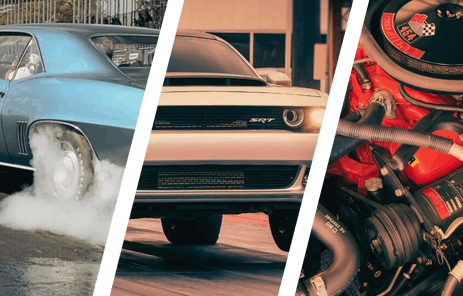 Within the pantheon of high-performance Pontiac’s, the Formula 400 is remembered as the strong silent type. Born with the Firebird’s 2nd generation as a 1970-1/2 model, the Formula 400, by design, received less lime light than its Trans Am sibling. However, it was every bit as formidable from stoplight to stoplight, becoming the bird of choice for those who wanted to speak softly, but carry 400-cubes.
Within the pantheon of high-performance Pontiac’s, the Formula 400 is remembered as the strong silent type. Born with the Firebird’s 2nd generation as a 1970-1/2 model, the Formula 400, by design, received less lime light than its Trans Am sibling. However, it was every bit as formidable from stoplight to stoplight, becoming the bird of choice for those who wanted to speak softly, but carry 400-cubes.
Replacing the 1967-’69 Firebird 400, the new Formula 400 was aptly named for the open wheel Grand Prix race series and its available engines. The standard motor was the L78 400-cid V8 with 10.25:1 compression rated at 330-hp/430 lb-ft, and the optional mill was the L74 H.O 400 V8, better known as the Ram Air III. With higher 10.75:1 compression and five more ponies at 345, the RA IIIs longer legs were its draw, making full power and the same jet-liner-like torque at higher rpms.
Also, technically available was the top dog Ram Air IV, but due to Pontiac’s refusal to advertise this fact for fear of taking away the GTOs top dog status, only 88 T/As got the RA IV and no Formulas. Both 400s came married to a standard 3-speed floor-wielded stick and Hurst shifter, with two 4-speeds and a 3-speed automatic as options.
Putting it to the ground was par for the course with the 2nd gen Firebirds, and the Formula’s firm yet comfortable suspension was up to the task. Not as unforgiving as the T/As components that were an option, the Formula came with firmer springs/shocks, front/rear stabilizer bars and standard power front disc brakes.
Where the Trans Am was, without argument, an “in your face machine”, the Formula 400 calmly exhibited a more subdued swagger, allowing the 2nd gen Firebird’s gorgeous Italian sports car-inspired lines to shine without the race car stripes, spoilers and canards adorning its extroverted brother. Think of the Formula 400 as a UFC fighter in a well-tailored suit, sharp sophistication on the outside, yet brute strength beneath – and you get the idea.
The Formula did have its distinguishing features however, including one of the coolest hoods ever to emerge from Pontiac’s design studio. When the RA III motor was ordered, the dual-scooped hood provided functional Ram Air induction, via two rubber-sealed underhood ducts that channeled outside air into the 4-barrel carb.
Additionally, “RAM AIR” decals on the scoops enlightened wood-be competitors to this fact. The Formula also wore the new die-cast Firebird symbol on its Endura beak, along with front fender-mounted Formula 400 badges, both adding to a more upscale (GT) Grand Touring car look.
The Formula’s cockpit was similar to the T/A, save for a deluxe steering wheel and a fau-woodgrain gauge overlay instead of the T/As engine-turned metal. Options included the steering wheel that shares its name.
In the long (hood) and short (deck) of it, The formula 400 took the 2nd gen Firebird to new heights, not in race-inspired aggressive fashion like the T/A, but in the opposite direction, becoming a sort of restrained yet potent machine for the more sophisticated buyer.
Packing all the performance goodies and capabilities of the road race-ready T/A in a less radical package, the Formula 400, intersected the lines between pony/muscle car and European-styled GT sport coupe and did it beautifully, just as Pontiac intended.
You might also like
SEMA 2025: Superformance Godzilla Cobra Snake Packs 1,000 HP
The Godzilla Cobra is a 1,000hp tribute to Carroll Shelby. Superformance's new CSX10000 features a supercharged 7.3L V8.










